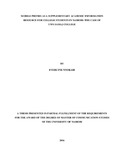| dc.contributor.author | Nyokabi, Everlyne | |
| dc.date.accessioned | 2017-01-05T05:20:52Z | |
| dc.date.available | 2017-01-05T05:20:52Z | |
| dc.date.issued | 2016 | |
| dc.identifier.uri | http://hdl.handle.net/11295/98950 | |
| dc.description.abstract | Mobile phones are ever-present among college students and are frequently used in accessing learning resources among college students. This study using Koole (2006) Frame model and Davis‘s (1986) Technology Acceptance Model sought to investigate the extent of the utilization of mobile phones as a supplementary academic information resource for college students of UWS Samaj College in Nairobi in Kenya. The study was guided by the following objectives: the extent to which students are using mobile phones to access learning materials, how students are using mobile phone services to access learning materials and the kind of academic information accessed via mobile phones to enhance learning process among students in UWS Samaj College. Reviewed literature indicates that mobile phones are gradually supporting learners in accessing academic information in many areas. However, the use of mobile phone as a supplementary academic information resource can only be conceived by higher learning institutions in relation to the institutional rules and policy. Establishing the extent to which mobile phones are used as a supplementary academic resource and the kind of academic content accessed will help in informing the higher learning institutions and policy makers. This study adopted an explorative research design using census method where by in-depth interviews, observations, and questionnaires were used. The data collected from a sample comprising 150 students, five lectures and one administrator was analysed using mixed method (both quantitative and qualitative approaches). A total of 156 respondents participated in the study. Quantitative data was analysed descriptively by use of Statistical Package for Social Sciences (SPSS) while qualitative data was analysed using content analysis. The analysed quantitative data was presented using frequency distribution tables and figures while analysed qualitative data was presented by description and narration. Findings showed that the lecturers, students and administrators had phones that were used depending on their needs. The presence of cell phones presents a host of options and challenges for today‘s students. Cell phones are undeniably convenient, helpful tools for study and can be a hurtful source of distraction depending on the attitude and use pattern of a student. However, utilisation was done informally since mobile phones have not been integrated in learning in most higher education learning institutions. The study recommended that mobile phones should be formally integrated in the entire education system but guided by a well formulated policy. | en_US |
| dc.language.iso | en | en_US |
| dc.publisher | University of Nairobi | en_US |
| dc.rights | Attribution-NonCommercial-NoDerivs 3.0 United States | * |
| dc.rights.uri | http://creativecommons.org/licenses/by-nc-nd/3.0/us/ | * |
| dc.subject | Mobile Phones as a Supplementary Academic Information Resource for College Students | en_US |
| dc.title | Mobile Phones as a Supplementary Academic Information Resource for College Students in Nairobi: the Case of Uws Samaj College | en_US |
| dc.type | Thesis | en_US |



